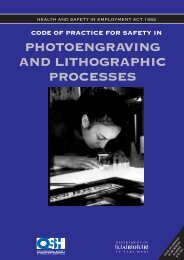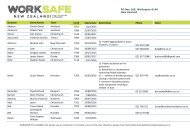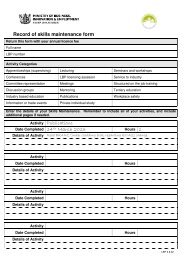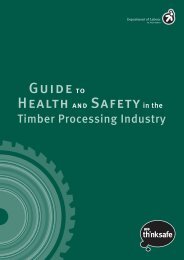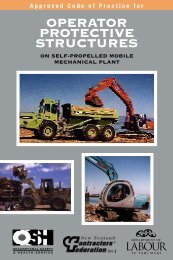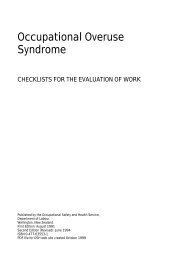Health and Safety Issues in New Zealand ... - Business.govt.nz
Health and Safety Issues in New Zealand ... - Business.govt.nz
Health and Safety Issues in New Zealand ... - Business.govt.nz
Create successful ePaper yourself
Turn your PDF publications into a flip-book with our unique Google optimized e-Paper software.
Discussion<br />
Only one <strong>in</strong>stitution met the facility <strong>and</strong> work practice st<strong>and</strong>ards required of a<br />
mortuary carry<strong>in</strong>g out high-risk procedures.<br />
Eight <strong>in</strong>stitutions do not meet the st<strong>and</strong>ards required of a basic facility <strong>and</strong> require<br />
immediate improvement. OSH departmental medical practitioners (DMPs) have<br />
written letters to the managers outl<strong>in</strong><strong>in</strong>g the sorts of improvements required to<br />
achieve compliance.<br />
Seven other facilities required eng<strong>in</strong>eer<strong>in</strong>g improvements of changes <strong>in</strong> work practices<br />
to achieve compliance with the HSE Act to meet the st<strong>and</strong>ards of a “basic facility” that<br />
OSH would see as the m<strong>in</strong>imum for “st<strong>and</strong>ard” autopsies.<br />
OSH developed the “st<strong>and</strong>ards” for this audit from <strong>in</strong>ternational documents. Although<br />
the risks of an autopsy are relatively low, they are potentially fatal <strong>and</strong> OSH feels that,<br />
given the presence of these <strong>in</strong>ternational recommendations, <strong>New</strong> Zeal<strong>and</strong> <strong>in</strong>stitutions<br />
must meet this st<strong>and</strong>ard.<br />
It is OSH’s view that elim<strong>in</strong>ation of these risks is not practicable.<br />
Isolation (of the high-risk cases) does seem a practical option for some <strong>in</strong>stitutions<br />
<strong>and</strong>, <strong>in</strong> OSH’s view, should be considered if the cost of upgrad<strong>in</strong>g a local facility is<br />
excessive. Isolat<strong>in</strong>g the risk to well-ma<strong>in</strong>ta<strong>in</strong>ed, suitable facilities with well-tra<strong>in</strong>ed<br />
staff not only decreases the health <strong>and</strong> safety risk but must have important benefits<br />
for quality control issues. Isolation is, however, complicated by forensic <strong>and</strong> cultural<br />
issues.<br />
M<strong>in</strong>imisation will rema<strong>in</strong> the risk control mechanism of choice for most <strong>in</strong>stitutions. It<br />
is vital, however, that <strong>in</strong>stitutions accept that some <strong>in</strong>vestment <strong>in</strong> eng<strong>in</strong>eer<strong>in</strong>g<br />
solutions is necessary, particularly ventilation, <strong>and</strong> that strict adherence to work<br />
practices, however familiar, is required. It is OSH’s recommendation that the<br />
follow<strong>in</strong>g pr<strong>in</strong>ciples apply to any mortuary facility:<br />
1. That an “autopsy manager” (circulator) with responsibility for the health <strong>and</strong><br />
safety aspects (as well as the quality control, professional st<strong>and</strong>ards, etc.) be<br />
appo<strong>in</strong>ted for each case. This person has the authority to set the health <strong>and</strong><br />
safety st<strong>and</strong>ards for that case, <strong>in</strong>clud<strong>in</strong>g the ability to stop or decl<strong>in</strong>e the case if<br />
necessary. The pathologist would seem the logical choice.<br />
2. That the autopsy facility be purpose-designed <strong>and</strong> kept abreast of new or<br />
chang<strong>in</strong>g recommendations <strong>in</strong> the future.<br />
3. That each facility have clearly demarcated “dirty”, “transition” <strong>and</strong> “clean” areas.<br />
Chang<strong>in</strong>g, rest <strong>and</strong> eat<strong>in</strong>g areas are conf<strong>in</strong>ed to the clean area, as are storage <strong>and</strong><br />
other general use areas.<br />
4. That the “dirty” area of the mortuary complex be at a negative air pressure to the<br />
rest of the facility <strong>and</strong> that there be at least 6 air changes per hour <strong>in</strong> this area.<br />
OSH’s preference is for 12 air changes per hour 4 . The air flow should be from<br />
ceil<strong>in</strong>g entry to floor exit.<br />
5. That the air from the “dirty” area of the complex be either vented directly to the<br />
exterior (but not <strong>in</strong>to surround<strong>in</strong>g build<strong>in</strong>gs) or to the atmosphere via an HEPA<br />
filter. The air should not be recirculated.<br />
44<br />
<strong>Health</strong> <strong>and</strong> <strong>Safety</strong> <strong>Issues</strong> <strong>in</strong> <strong>New</strong> Zeal<strong>and</strong> Mortuaries


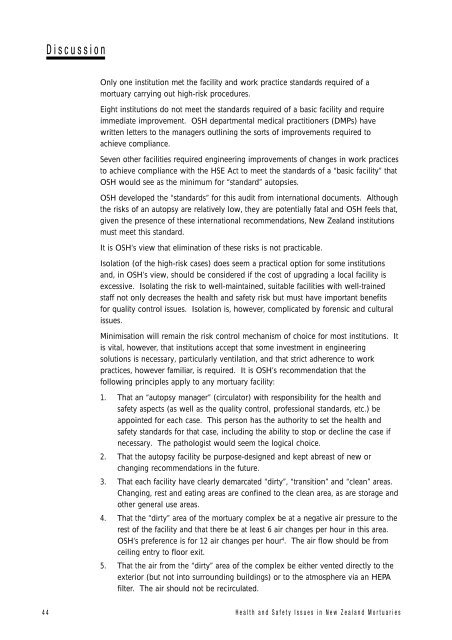

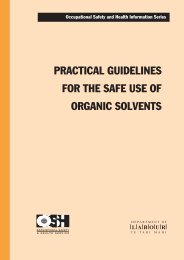
![Task analysis worksheet [161 KB PDF] - Business.govt.nz](https://img.yumpu.com/51400981/1/190x135/task-analysis-worksheet-161-kb-pdf-businessgovtnz.jpg?quality=85)

